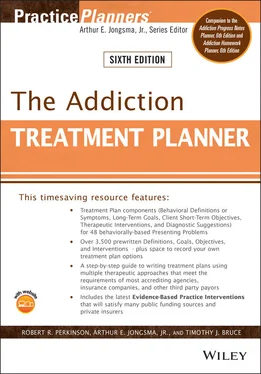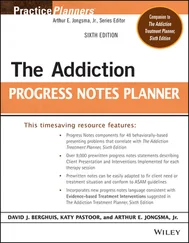The Addiction Treatment Planner
Здесь есть возможность читать онлайн «The Addiction Treatment Planner» — ознакомительный отрывок электронной книги совершенно бесплатно, а после прочтения отрывка купить полную версию. В некоторых случаях можно слушать аудио, скачать через торрент в формате fb2 и присутствует краткое содержание. Жанр: unrecognised, на английском языке. Описание произведения, (предисловие) а так же отзывы посетителей доступны на портале библиотеки ЛибКат.
- Название:The Addiction Treatment Planner
- Автор:
- Жанр:
- Год:неизвестен
- ISBN:нет данных
- Рейтинг книги:4 / 5. Голосов: 1
-
Избранное:Добавить в избранное
- Отзывы:
-
Ваша оценка:
- 80
- 1
- 2
- 3
- 4
- 5
The Addiction Treatment Planner: краткое содержание, описание и аннотация
Предлагаем к чтению аннотацию, описание, краткое содержание или предисловие (зависит от того, что написал сам автор книги «The Addiction Treatment Planner»). Если вы не нашли необходимую информацию о книге — напишите в комментариях, мы постараемся отыскать её.
The Addiction Treatment Planner, Sixth Edition
The Additction Treatment Planner, Sixth Edition
The Addiction Treatment Planner — читать онлайн ознакомительный отрывок
Ниже представлен текст книги, разбитый по страницам. Система сохранения места последней прочитанной страницы, позволяет с удобством читать онлайн бесплатно книгу «The Addiction Treatment Planner», без необходимости каждый раз заново искать на чём Вы остановились. Поставьте закладку, и сможете в любой момент перейти на страницу, на которой закончили чтение.
Интервал:
Закладка:
| ICD-10-CM | DSM-5 Disorder, Condition, or Problem |
|---|---|
| F41.9 | Unspecified anxiety disorder |
| F41.1 | Generalized anxiety disorder |
| F41.8 | Other specified anxiety disorder |
| F93.0 | Separation anxiety disorder |
| F43.22 | Adjustment disorder, With anxiety |
| F60.4 | Histrionic personality disorder |
| F60.6 | Avoidant personality disorder |
| F60.7 | Dependent personality disorder |
Note
1  Indicates that the Objective/Intervention is consistent with those found in evidence-based treatments.
Indicates that the Objective/Intervention is consistent with those found in evidence-based treatments.
ATTENTION-DEFICIT/HYPERACTIVITY DISORDER (ADHD) – ADOLESCENT
BEHAVIORAL DEFINITIONS
1 Often fails to give close attention to detail or makes mistakes
2 Often fidgets with or taps hands and feet, or squirms in seat
3 Often has difficulty sustaining attention in tasks or activities
4 Often does not seem to listen when spoken to directly
5 Often feels restless
6 Often does not follow through on instructions and fails to finish duties
7 Often unable to engage in leisure activities quietly
8 Often has difficulty organizing tasks and activities
9 Is often “on the go,” acting as if “driven by a motor”
10 Often avoids, dislikes, or is reluctant to engage in tasks that require sustained mental effort
11 Often talks excessively
12 Often loses things necessary for tasks or activities
13 Often interrupts, doesn't wait for his/her/their turn, or blurts out answers before a question has been completed
14 Is easily distracted by extraneous stimuli
15 Is often forgetful in daily activities
16 Hyperactivity as evidenced by a high energy level, restlessness, difficulty sitting still, or loud or excessive talking.
17 Attention-Deficit/Hyperactivity Disorder (ADHD) increases vulnerability to addictive behaviors.
LONG-TERM GOALS
1 Maintain a program of recovery from addiction, and reduce the negative effects of ADHD on learning, social interaction, and self-esteem.
2 Develop the coping skills necessary to improve ADHD and eliminate addiction.
3 Understand the relationship between ADHD symptoms and addiction.
4 Sustain attention and concentration for consistently longer periods of time and increase the frequency of on-task behaviors.
5 Demonstrate marked improvement in impulse control.
6 Regularly take medication as prescribed to decrease impulsivity, hyperactivity, and distractibility.
7 Parents and/or teachers successfully utilize a reward system, contingency contract, or token economy to reinforce positive behaviors and deter negative behaviors.
8 Develop positive social skills to help maintain lasting peer friendships.
| SHORT-TERM OBJECTIVES | THERAPEUTIC INTERVENTIONS |
|---|---|
 Work cooperatively with the therapist toward agreed-upon therapeutic goals while being as open and honest as comfort and trust allow. (1, 2) Work cooperatively with the therapist toward agreed-upon therapeutic goals while being as open and honest as comfort and trust allow. (1, 2) |
Establish rapport with the client toward building a strong therapeutic alliance; convey caring, support, warmth, and empathy; provide nonjudgmental support and develop a level of trust with the client toward him/her/their feeling safe to discuss his/her/their ADHD vulnerabilities and their impact on his/her/their life.  |
Strengthen powerful relationship factors within the therapy process and foster the therapy alliance through paying special attention to these empirically supported factors: work collaboratively with the client in the treatment process; reach agreement on the goals and expectations of therapy; demonstrate consistent empathy toward the client's feelings and struggles; verbalize positive regard toward and affirmation of the client; and collect and deliver client feedback as to the client's perception of his/her/their progress in therapy (see Psychotherapy Relationships That Work: Vol. 1 by Norcross & Lambert and Psychotherapy Relationships That Work: Vol. 2 by Norcross & Wampold).  |
|
| Client and parents describe the nature of the ADHD including specific behaviors, triggers, and consequences. (3, 4) | Thoroughly assess the various stimuli (e.g. situations, people, thoughts) that have triggered the client's ADHD behavior; the thoughts, feelings, and actions that have characterized his/her/their responses; and the consequences of the behavior (e.g. reinforcements, punishments), toward identifying target behaviors, antecedents, consequences, and the appropriate placement of interventions (e.g. school-based, home-based, peer-based). |
| Rule out alternative conditions/causes of inattention, hyperactivity, and impulsivity (e.g. other behavioral, physical, emotional problems, or normal developmental behavior). | |
| Complete psychological testing or objective questionnaires for assessing ADHD and substance abuse and/or to rule out emotional factors or learning disabilities as the basis for maladaptive behavior. (5) | Administer to the client psychological instruments designed to objectively assess ADHD (e.g. the ADHD Rating Scale-IV; Substance Abuse Subtle Screening Inventory-3; the Disruptive Behavior Rating Scale); give the client feedback regarding the results of the assessment; readminister as needed to assess response to treatment. |
| Identify and monitor the symptoms of ADHD and their impact on daily living. (6) | Teach the client how to monitor ADHD symptoms, rate their severity on a scale (e.g. 0–10), and (if indicated) record their consequences; implement daily self-monitoring. |
| Provide behavioral, emotional, and attitudinal information toward an assessment of specifiers relevant to a DSM diagnosis, the efficacy of treatment, and the nature of the therapy relationship. (7, 8, 9, 10) | Assess the client's level of insight (syntonic versus dystonic) toward the presenting problems (e.g. demonstrates good insight into the problematic nature of the described behavior, agrees with others' concern, and is motivated to work on change; demonstrates ambivalence regarding the problem described and is reluctant to address the issue as a concern; or demonstrates resistance regarding acknowledgment of the problem described, is not concerned, and has no motivation to change). |
| Assess the client for evidence of research-based correlated disorders (e.g. oppositional defiant behavior with ADHD, depression secondary to an anxiety disorder) including vulnerability to suicide, if appropriate (e.g. increased suicide risk when comorbid depression is evident). | |
| Assess for any issues of age, gender, or culture that could help explain the client's currently defined problem behavior and factors that could offer a better understanding of the client's behavior. | |
| Assess for the severity of the level of impairment to the client's functioning to determine appropriate level of care (e.g. the behavior noted creates mild, moderate, severe, or very severe impairment in social, relational, vocational, or occupational endeavors); continuously assess this severity of impairment as well as the efficacy of treatment (e.g. the client no longer demonstrates severe impairment but the presenting problem now is causing mild or moderate impairment). | |
| Verbalize the powerlessness and unmanageability that resulted from treating ADHD symptoms with addiction. (11) | Using a 12-step recovery program's Step One exercise, help the client to accept his/her/their powerlessness and unmanageability over ADHD symptoms and addiction (or assign the client to complete the Step 1 exercise from The Alcoholism and Drug Abuse Client Workbook by Perkinson). |
| Verbalize the relationship between ADHD and addiction. (12) | Using a biopsychosocial approach, teach the client about the relationship between ADHD symptoms and the vulnerability to substance use (see Substance Use in Adolescents with ADHD by Kennedy et al.). |
| Implement a program of recovery structured to bring ADHD and addiction under control. (13) | Help the client to develop a program of recovery that includes the elements necessary to bring ADHD and addiction under control (e.g. medication, behavior modification, environmental controls, aftercare meetings, further therapy); (or supplement with “Developing a Recovery Program” in the Addiction Treatment Homework Planner by Lenz, Finley, & Jongsma). |
| List five ways a higher power can be used to assist in recovery from ADHD and addiction. (14) | Teach the client about the Alcoholics Anonymous concept of a higher power and how this power can assist him/her/them in recovery. |
| Implement remedial procedures for any learning disabilities that add to the client's frustration. (15) | Refer the client to an educational specialist to design remedial procedures for any learning disabilities that may be present in addition to ADHD. |
 Take medication as prescribed. (16, 17) Take medication as prescribed. (16, 17) |
Arrange for a medication evaluation by a prescriber.  |
Monitor the client for psychotropic medication prescription compliance, side effects, and effectiveness; consult with the prescriber at regular intervals (or supplement with “Evaluating Medication Effects” in the Adolescent Psychotherapy Homework Planner by Jongsma, Peterson, McInnis, & Bruce).  |
|
 Parents and the client verbalize increased knowledge about ADHD symptoms. (18, 19, 20, 21) Parents and the client verbalize increased knowledge about ADHD symptoms. (18, 19, 20, 21) |
Educate the client and/or client's parents about the signs and symptoms of ADHD.  |
Discuss with the client and/or parents the various treatment options for ADHD (e.g. behavioral parent training, classroom-based behavioral management programs, peer-based programs, medication, cognitive behavioral therapy [CBT]), discussing risks, benefits, and matching treatment to developmental age to fully inform the client's and parents' decision making (see ADHD in Adolescents by Becker).  |
|
Assign the parents readings to increase their knowledge of ADHD (e.g. Taking Charge of ADHD by Barkley; Parenting Children with ADHD: 10 Lessons That Medicine Cannot Teach by Monastra; The Family ADHD Solution: A Scientific Approach to Maximizing Your Child's Attention and Minimizing Parental Stress by Bertin).  |
|
Assign the client readings to increase his/her/their knowledge about ADHD and ways to manage related behavior (e.g. The ADHD Workbook for Teens: Activities to Help You Gain Motivation and Confidence by Honos-Webb; Take Control of ADHD: The Ultimate Guide for Teens With ADHD by Spodak & Stephano; ADHD – A Teenager's Guide by Crist).  |
|
 Parents learn and implement Parent Management Training to increase prosocial behavior and decrease disruptive behavior of their adolescent child/children. (22, 23, 24, 25, 26) Parents learn and implement Parent Management Training to increase prosocial behavior and decrease disruptive behavior of their adolescent child/children. (22, 23, 24, 25, 26) |
Explain how parent and child behavioral interactions can reduce the frequency of impulsive, disruptive, and negative attention-seeking behaviors and increase desired prosocial behavior through prompting and reinforcing positive behaviors as well as use of clear instruction, time-out, and other loss-of-privilege practices for problem behavior (recommend The Kazdin Method for Parenting the Defiant Child by Kazdin; Parents and Adolescents Living Together: The Basics by Patterson & Forgatch).  |
Teach the parents how to specifically define and identify problem behaviors, identify their reactions to the behavior, determine whether the reaction encourages or discourages the behavior, and generate alternatives to the problem behavior (or supplement with “Switching from Defense to Offense” in the Adolescent Psychotherapy Homework Planner by Jongsma, Peterson, McInnis, & Bruce).  |
|
Teach parents about the possible functions of the ADHD behavior (e.g. avoidance, attention, to gain a desired object/activity, regulate sensory stimulation); how to test which function(s) is being served by the behavior; and how to use parent-training methods to manage the behavior.  |
|
Assign the parents home exercises in which they implement and record results of reinforcing prosocial behavior (or supplement with “Clear Rules, Positive Reinforcement, Appropriate Consequences” in the Adolescent Psychotherapy Homework Planner by Jongsma, Peterson, McInnis, & Bruce); review in session, providing corrective feedback toward improved, appropriate, and consistent use of skills.  |
|
Refer parents to a Parent Management Training course (e.g. see https://childmind.org/article/choosing-a-parent-training-program).  |
|
 Parents work with therapist and school to implement a Behavioral Classroom Management program. (27, 28) Parents work with therapist and school to implement a Behavioral Classroom Management program. (27, 28) |
Consult with the client's teachers to implement age-appropriate strategies to improve school performance, such as sitting in the front row during class, using a prearranged signal to redirect the client back to task, scheduling breaks from tasks, providing frequent feedback, calling on the client often, arranging for a listening friend, and implementing a daily behavioral report card.  |
Consult with parents and pertinent school personnel to implement an age-appropriate Behavioral Classroom Management intervention (see ADHD in the Schools by DuPaul & Stoner) that reinforces appropriate behavior at school and at home, uses time-out for undesirable behavior, and uses a daily behavioral report card to monitor progress.  |
|
 Complete a peer-based treatment program focused on improving social interaction skills. (29) Complete a peer-based treatment program focused on improving social interaction skills. (29) |
Conduct or refer the client to a Behavioral Peer Intervention (e.g. Summer Treatment Program or after school/weekend version) that involves brief social skills training followed by coached group play in recreational activities guided by contingency management systems (e.g. point system, time-out) and utilizing objective observations, frequency counts, and adult ratings of social behaviors as outcome measures (see Summer Treatment Programs for Attention-Deficit Hyperactivity Disorder by Pelham, et al.).  |
 Identify and implement tactics, strategies, and skills for maximizing focused productivity and minimizing interference bought on by ADHD vulnerabilities. (30, 31, 32, 33, 34, 35) Identify and implement tactics, strategies, and skills for maximizing focused productivity and minimizing interference bought on by ADHD vulnerabilities. (30, 31, 32, 33, 34, 35) |
Provide psychoeducation about ADHD or ADHD and addiction and orient the adolescent client to the CBT model and its rationale including cognitive and behavioral skills such as organization, planning, adaptive thinking, while reducing distraction and procrastination to improve focused productivity (see Cognitive-Behavioral Therapy for Adolescents by Sprich & Burbridge; Substance Use in Adolescents with ADHD by Kennedy et al.; Substance Use chapter in this Planner ).  |
Teach organizing and planning skills including the creation of a centralized and prioritized task list.  |
|
Teach distraction delay and cue-controlled techniques that respectively involve writing down distractions while working and coming back to them after a set amount of time and instructing the client to check in with him or herself regularly (e.g. every 30 min) to assess if he or she was still working on the task at hand or if he or she had gotten distracted.  |
|
Use cognitive restructuring to teach adaptive thinking skills and respond adaptively to task-interfering thinking including anxious, depressive, or overly positive thinking that does not recognize the effects of attentional deficits.  |
|
Teach skills to reduce procrastination including scheduling tasks, breaking them down into manageable steps, learning to set realistic goals for completing tasks, and rethinking beliefs about perfectionism.  |
|
Conduct relapse prevention in which all skills are reviewed, continued use is encouraged, and coping with potential future difficulties are rehearsed; ask client to schedule a self-check-in one month after the last treatment session.  |
|
 Parents develop and utilize an organized system to keep track of the client's school assignments, chores, and household responsibilities. (36) Parents develop and utilize an organized system to keep track of the client's school assignments, chores, and household responsibilities. (36) |
Assist the parents in developing and implementing an organizational system to increase the client's on-task behaviors and completion of school assignments, chores, or household responsibilities using calendars, charts, notebooks, and class syllabi (or supplement with “Getting It Done” in the Adolescent Psychotherapy Homework Planner by Jongsma, Peterson, McInnis, & Bruce). |
| Increase frequency of completion of school assignments, chores, and household responsibilities. (37, 38) | Assist the parents in developing a routine schedule to increase the client's compliance with school, household, or work-related responsibilities. |
| Encourage the parents and teachers to utilize a school contract and reward system to reinforce completion of the client's assignments (or supplement with “Getting It Done” program in the Adolescent Psychotherapy Homework Planner by Jongsma, Peterson, McInnis, & Bruce). | |
| Identify and implement effective test-taking strategies on a consistent basis to improve academic performance. (39) | Teach the client more effective test-taking strategies (e.g. reviewing material regularly, reading directions twice, rechecking work; see Test-Taking Strategies by Kesselman-Turkel & Peterson). |
| Cite instances in which instant gratification was delayed in favor of achieving meaningful long-term goals. (40, 41) | Teach the client mediational and self-control strategies (e.g. “stop, look, listen, and think”) to delay the need for instant gratification and inhibit impulses to achieve more meaningful, long-term goals (or supplement with “Problem Solving Exercise” in the Adolescent Psychotherapy Homework Planner by Jongsma, Peterson, McInnis, & Bruce). |
| Assist the parents in increasing structure to help the client learn to delay gratification for longer-term goals (e.g. completing homework or chores before playing basketball). | |
| Identify what social skills were implemented to reduce anxiety and build confidence in social interactions. (42, 43, 44) | Use instruction, modeling, and role-playing to build the client's general social and/or communication skills. |
| Work with the parents and assign exercises that facilitate the client's use of social skills in various everyday situations. | |
| Assign the client to read about general social and/or communication skills in books or treatment manuals on building social skills (e.g. Your Perfect Right by Alberti & Emmons; Conversationally Speaking by Garner); or supplement with “Social Skills Exercise” in the Adolescent Psychotherapy Homework Planner by Jongsma, Peterson, McInnis, & Bruce. | |
| Identify and implement effective problem-solving strategies. (45, 46) | Teach the client effective problem-solving skills (e.g. identifying the problem, brainstorming alternative solutions, selecting an option, implementing a course of action, and evaluating the results). |
| Use role-playing and modeling to teach the client how to implement effective problem-solving techniques in his/her/their daily life; work with the parents and assign exercises that facilitate the client's use of problem solving in various everyday situations. | |
| Cite which constructive coping strategies were implemented when the negative emotions associated with failure were a potential trigger for addiction. (47, 48) | Review specific instances of failure to learn and the negative emotions associated with the experience; focus on how addictive behavior was used to escape from negative emotions. |
| Role-play and model constructive alternative coping behaviors to use in failure-to-learn situations (e.g. cognitive focusing, deep breathing, make lists, reduce distractions, shorten learning sessions, repeat instructions verbally). | |
| Report instances when relaxation techniques reduced tension and frustration while increasing focus in a learning situation. (49, 50) | Using techniques like progressive relaxation, guided imagery, or biofeedback, teach the client how to relax completely; assign him/her/them to relax twice per day for 10 to 20 min per session. |
| Encourage the client to incorporate relaxation skills as a coping and focusing mechanism when feeling tense and frustrated by a learning situation or urge to use substances; review implementation; reinforce success and problem-solve obstacles. | |
| Develop and implement an exercise program that includes exercising at a training heart rate for at least 20 min at least three times per week. (51) | Help the client develop an exercise program; increase the exercise by 10% each week until the client is exercising at a training heart rate for at least 20 min, at least three times a week. |
| Develop an aftercare program that includes regular attendance at recovery group meetings, getting a sponsor, and continuing the therapy necessary to bring ADHD and addiction under control. (52) | Help the client to develop an aftercare program that includes regular attendance at recovery group meetings, getting a sponsor, and continuing the therapy necessary to bring ADHD and addictive behavior under control (or supplement with “Aftercare Plan Components” in the Adult Psychotherapy Homework Planner by Jongsma & Bruce). |
| Complete a survey to assess the degree of satisfaction with treatment. (53) | Administer a survey to assess the client's degree of satisfaction with treatment. |
DIAGNOSTIC SUGGESTIONS
Интервал:
Закладка:
Похожие книги на «The Addiction Treatment Planner»
Представляем Вашему вниманию похожие книги на «The Addiction Treatment Planner» списком для выбора. Мы отобрали схожую по названию и смыслу литературу в надежде предоставить читателям больше вариантов отыскать новые, интересные, ещё непрочитанные произведения.
Обсуждение, отзывы о книге «The Addiction Treatment Planner» и просто собственные мнения читателей. Оставьте ваши комментарии, напишите, что Вы думаете о произведении, его смысле или главных героях. Укажите что конкретно понравилось, а что нет, и почему Вы так считаете.












